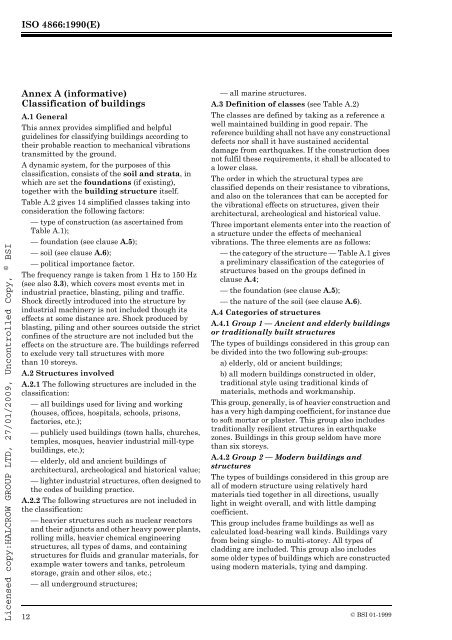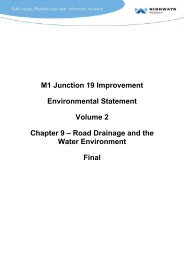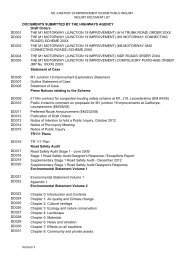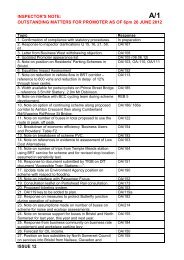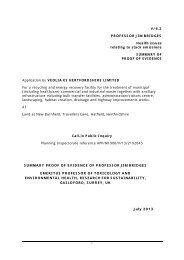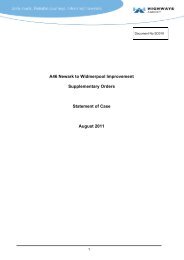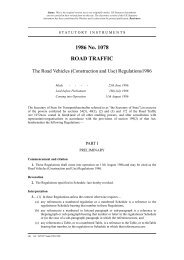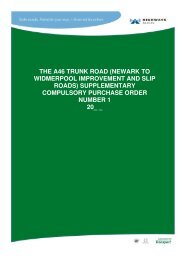Evaluation and Measurement for Vibration in Buildings Part 1, BSI ...
Evaluation and Measurement for Vibration in Buildings Part 1, BSI ...
Evaluation and Measurement for Vibration in Buildings Part 1, BSI ...
You also want an ePaper? Increase the reach of your titles
YUMPU automatically turns print PDFs into web optimized ePapers that Google loves.
ISO 4866:1990(E)<br />
Licensed copy:HALCROW GROUP LTD, 27/01/2009, Uncontrolled Copy, © <strong>BSI</strong><br />
Annex A (<strong>in</strong><strong>for</strong>mative)<br />
Classification of build<strong>in</strong>gs<br />
A.1 General<br />
This annex provides simplified <strong>and</strong> helpful<br />
guidel<strong>in</strong>es <strong>for</strong> classify<strong>in</strong>g build<strong>in</strong>gs accord<strong>in</strong>g to<br />
their probable reaction to mechanical vibrations<br />
transmitted by the ground.<br />
A dynamic system, <strong>for</strong> the purposes of this<br />
classification, consists of the soil <strong>and</strong> strata, <strong>in</strong><br />
which are set the foundations (if exist<strong>in</strong>g),<br />
together with the build<strong>in</strong>g structure itself.<br />
Table A.2 gives 14 simplified classes tak<strong>in</strong>g <strong>in</strong>to<br />
consideration the follow<strong>in</strong>g factors:<br />
— type of construction (as ascerta<strong>in</strong>ed from<br />
Table A.1);<br />
— foundation (see clause A.5);<br />
— soil (see clause A.6);<br />
— political importance factor.<br />
The frequency range is taken from 1 Hz to 150 Hz<br />
(see also 3.3), which covers most events met <strong>in</strong><br />
<strong>in</strong>dustrial practice, blast<strong>in</strong>g, pil<strong>in</strong>g <strong>and</strong> traffic.<br />
Shock directly <strong>in</strong>troduced <strong>in</strong>to the structure by<br />
<strong>in</strong>dustrial mach<strong>in</strong>ery is not <strong>in</strong>cluded though its<br />
effects at some distance are. Shock produced by<br />
blast<strong>in</strong>g, pil<strong>in</strong>g <strong>and</strong> other sources outside the strict<br />
conf<strong>in</strong>es of the structure are not <strong>in</strong>cluded but the<br />
effects on the structure are. The build<strong>in</strong>gs referred<br />
to exclude very tall structures with more<br />
than 10 storeys.<br />
A.2 Structures <strong>in</strong>volved<br />
A.2.1 The follow<strong>in</strong>g structures are <strong>in</strong>cluded <strong>in</strong> the<br />
classification:<br />
— all build<strong>in</strong>gs used <strong>for</strong> liv<strong>in</strong>g <strong>and</strong> work<strong>in</strong>g<br />
(houses, offices, hospitals, schools, prisons,<br />
factories, etc.);<br />
— publicly used build<strong>in</strong>gs (town halls, churches,<br />
temples, mosques, heavier <strong>in</strong>dustrial mill-type<br />
build<strong>in</strong>gs, etc.);<br />
— elderly, old <strong>and</strong> ancient build<strong>in</strong>gs of<br />
architectural, archeological <strong>and</strong> historical value;<br />
— lighter <strong>in</strong>dustrial structures, often designed to<br />
the codes of build<strong>in</strong>g practice.<br />
A.2.2 The follow<strong>in</strong>g structures are not <strong>in</strong>cluded <strong>in</strong><br />
the classification:<br />
— heavier structures such as nuclear reactors<br />
<strong>and</strong> their adjuncts <strong>and</strong> other heavy power plants,<br />
roll<strong>in</strong>g mills, heavier chemical eng<strong>in</strong>eer<strong>in</strong>g<br />
structures, all types of dams, <strong>and</strong> conta<strong>in</strong><strong>in</strong>g<br />
structures <strong>for</strong> fluids <strong>and</strong> granular materials, <strong>for</strong><br />
example water towers <strong>and</strong> tanks, petroleum<br />
storage, gra<strong>in</strong> <strong>and</strong> other silos, etc.;<br />
— all underground structures;<br />
— all mar<strong>in</strong>e structures.<br />
A.3 Def<strong>in</strong>ition of classes (see Table A.2)<br />
The classes are def<strong>in</strong>ed by tak<strong>in</strong>g as a reference a<br />
well ma<strong>in</strong>ta<strong>in</strong>ed build<strong>in</strong>g <strong>in</strong> good repair. The<br />
reference build<strong>in</strong>g shall not have any constructional<br />
defects nor shall it have susta<strong>in</strong>ed accidental<br />
damage from earthquakes. If the construction does<br />
not fulfil these requirements, it shall be allocated to<br />
a lower class.<br />
The order <strong>in</strong> which the structural types are<br />
classified depends on their resistance to vibrations,<br />
<strong>and</strong> also on the tolerances that can be accepted <strong>for</strong><br />
the vibrational effects on structures, given their<br />
architectural, archeological <strong>and</strong> historical value.<br />
Three important elements enter <strong>in</strong>to the reaction of<br />
a structure under the effects of mechanical<br />
vibrations. The three elements are as follows:<br />
— the category of the structure — Table A.1 gives<br />
a prelim<strong>in</strong>ary classification of the categories of<br />
structures based on the groups def<strong>in</strong>ed <strong>in</strong><br />
clause A.4;<br />
— the foundation (see clause A.5);<br />
— the nature of the soil (see clause A.6).<br />
A.4 Categories of structures<br />
A.4.1 Group 1 — Ancient <strong>and</strong> elderly build<strong>in</strong>gs<br />
or traditionally built structures<br />
The types of build<strong>in</strong>gs considered <strong>in</strong> this group can<br />
be divided <strong>in</strong>to the two follow<strong>in</strong>g sub-groups:<br />
a) elderly, old or ancient build<strong>in</strong>gs;<br />
b) all modern build<strong>in</strong>gs constructed <strong>in</strong> older,<br />
traditional style us<strong>in</strong>g traditional k<strong>in</strong>ds of<br />
materials, methods <strong>and</strong> workmanship.<br />
This group, generally, is of heavier construction <strong>and</strong><br />
has a very high damp<strong>in</strong>g coefficient, <strong>for</strong> <strong>in</strong>stance due<br />
to soft mortar or plaster. This group also <strong>in</strong>cludes<br />
traditionally resilient structures <strong>in</strong> earthquake<br />
zones. Build<strong>in</strong>gs <strong>in</strong> this group seldom have more<br />
than six storeys.<br />
A.4.2 Group 2 — Modern build<strong>in</strong>gs <strong>and</strong><br />
structures<br />
The types of build<strong>in</strong>gs considered <strong>in</strong> this group are<br />
all of modern structure us<strong>in</strong>g relatively hard<br />
materials tied together <strong>in</strong> all directions, usually<br />
light <strong>in</strong> weight overall, <strong>and</strong> with little damp<strong>in</strong>g<br />
coefficient.<br />
This group <strong>in</strong>cludes frame build<strong>in</strong>gs as well as<br />
calculated load-bear<strong>in</strong>g wall k<strong>in</strong>ds. Build<strong>in</strong>gs vary<br />
from be<strong>in</strong>g s<strong>in</strong>gle- to multi-storey. All types of<br />
cladd<strong>in</strong>g are <strong>in</strong>cluded. This group also <strong>in</strong>cludes<br />
some older types of build<strong>in</strong>gs which are constructed<br />
us<strong>in</strong>g modern materials, ty<strong>in</strong>g <strong>and</strong> damp<strong>in</strong>g.<br />
12<br />
© <strong>BSI</strong> 01-1999


